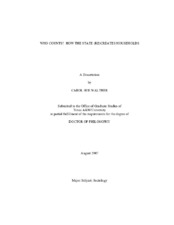| dc.description.abstract | Prior research focused upon the intersection of race, ethnicity, citizenship and identity produced as a result of the Census Schedule. In this dissertation, I focus on the Census, as an instrument of the state, to capture the process of inclusion and exclusion as it relates specifically to the intersection of sexualities and family formation. Using Sewell’s (1992) concept of dual structures, that is, cultural schemas and resources, I argue that sexuality is structural. Using mixed-methodology and three different data sources, I produce five different indices to determine settlement patterns of same-sex households in various geographic areas. Secondly, drawing on variables operationalized as cultural schema and resources, I identify characteristics of metropolitan areas that have arguably been related to levels of gay and lesbian concentration. In the multivariate context, the variables that are most influential in predicting levels of gay and lesbian concentration are physical temperature index, poverty rate, and heterosexual cohabitation rate. Variables focusing on characteristics of the metropolitan areas of relevance mainly to gays and lesbians such as those dealing with sodomy laws and anti-discrimination laws pertaining to sexual orientation, as well as the presence of political and religious conservatism are either not statistically important predictors or exhibited minimal influences. Through the Internet survey and thirty interviews, I examine how gay and lesbian couples answered the Census Schedule. The highest percentage of individuals marked single on the Census Schedule, suggesting that partnered homosexuals are being underenumerated by the Census Bureau. Furthermore, in regards to the Census and the state, two underlying ideas influence individuals’ enactments of agency: legal consciousness and statistical consciousness. Legal consciousness refers to people’s lay understandings of the law, while statistical consciousness refers to everyday knowledge of statistics. In both cases the production of legal interpretation and statistics by authoritative sources is then variously understood, consumed, and employed by ordinary citizens for their distinct purposes. This understanding takes on forms of generally unquestioned folk knowledge, despite being socially constructed in specific historical-cultural contexts. The production and consumption of statistics serve as a pivotal point of contestation of power and resistance, especially for these interviewees. | en |


